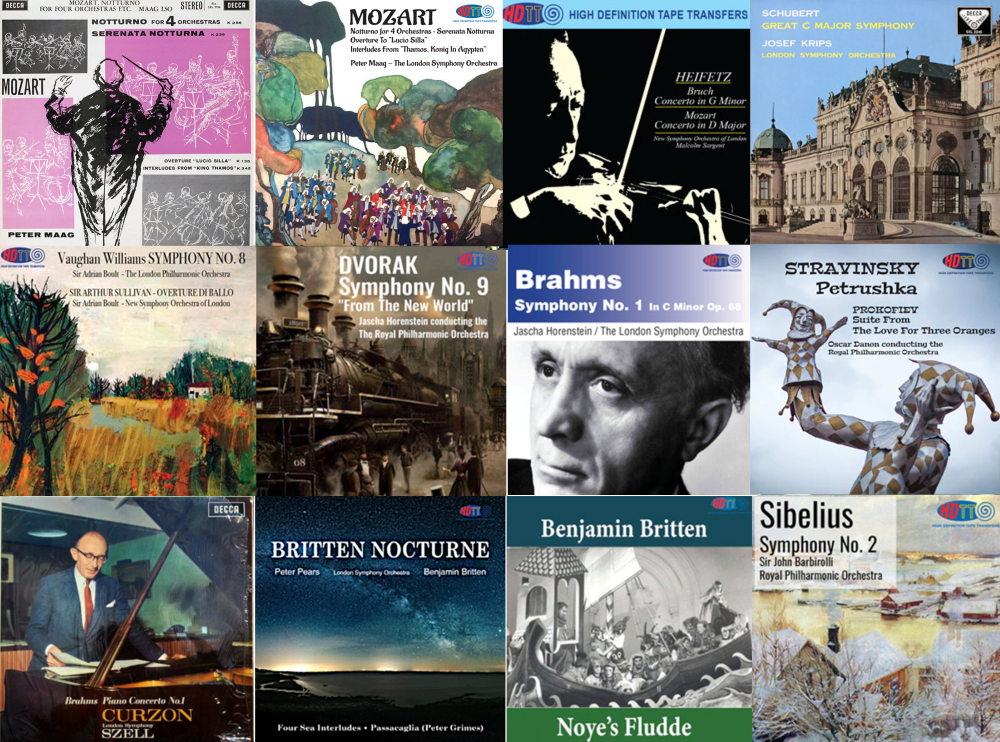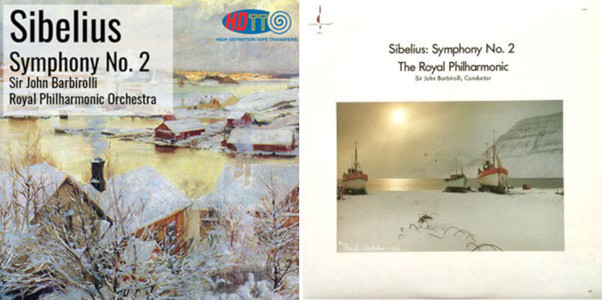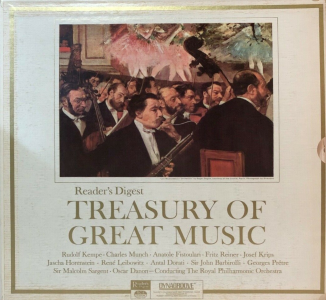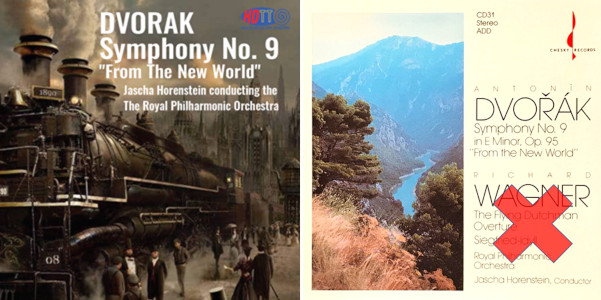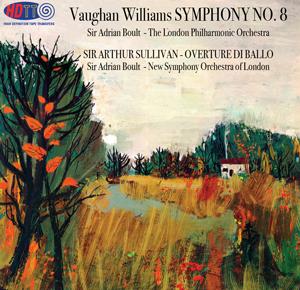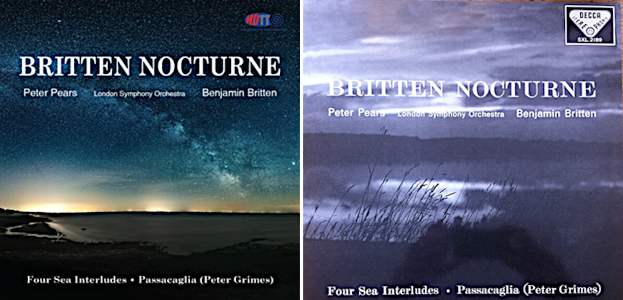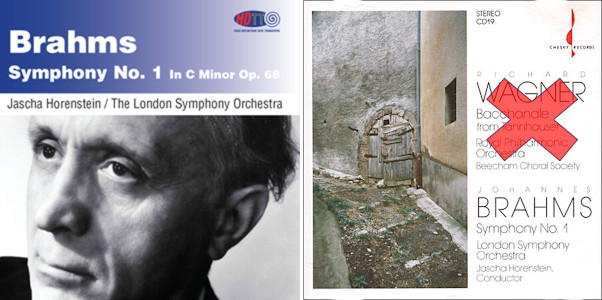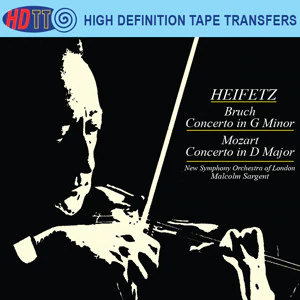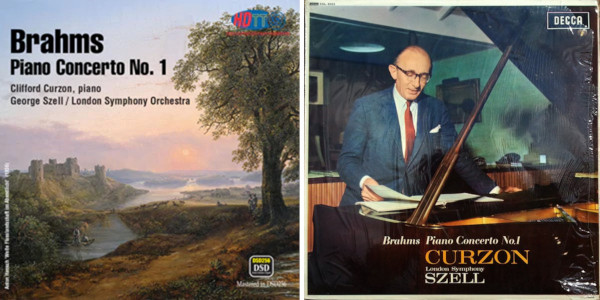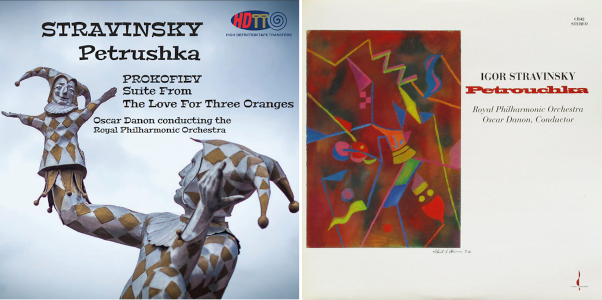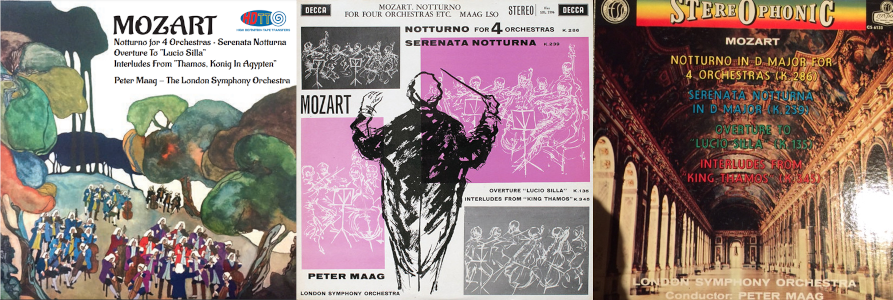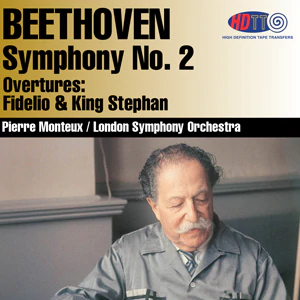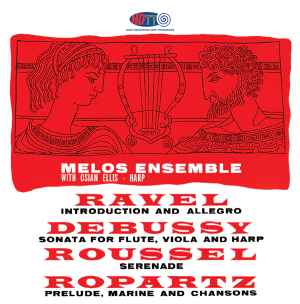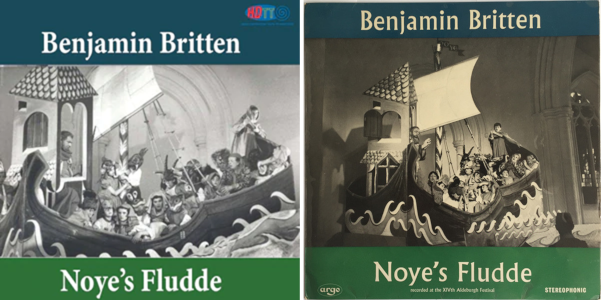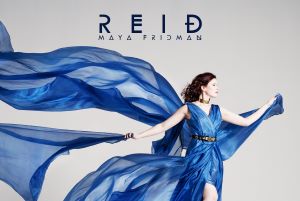I've written before about legendary Decca recording engineer Kenneth Wilkinson and the extensive collection of his recordings available from High Definition Tape Transfers. Since my original introductory article (HERE), HDTT has released more Wilkinson engineered recordings that are very much worthy of comment. And, I've found a few in the catalog that I'd missed before.
Why my continuing fascination with Wilkinson? Well, as one of the top recording engineers for Decca, Wilkinson's assignments regularly included some of the best artists Decca recorded. And his services were in high demand on Decca's contract engagements for RCA and Lyrita, providing another full range of excellent artists and performances. And then you have his own entrepreneurial adventures with Charles Gerhardt in their series of recordings for Readers Digest. Thus, one often finds with the recordings he engineered that wonderous combination of excellent sonics and great performances. The two don't so often go together as they do when Wilkinson is named in the credits.
So, let's look at some of these new (or newly found) HDTT releases.
Sibelius Symphony No. 2, Sir John Barbirolli, The Royal Philharmonic Orchestra. HDTT 1962/2022 (DXD) HERE
HDDT cover on left, Chesky reissue cover on right.
I was delighted to see this album released by HDTT. It's an old friend returned, and sounding better than ever. Barbirolli and the RPO create a magical performance, and the sonics are simply superb. This performance lived in my LP collection in both its original Readers Digest and later Chesky Records incarnations. It remains one of the top performances of this symphony even today.
Readers Digest Treasury of Great Music set containing some of the recordings by Wilkinson and Gerhardt.
The transfer by HDTT is clear, open and transparent; it's just excellent. They don't tell us the provenance of this tape, but it must be a good one given what I'm hearing in this DXD transfer. It has the openness and transparency that I hear most frequently with 2-track 15ips tapes, and sounds like it must be a kissing cousin to the master.
I enjoy many different recordings of the Sibelius Second (Monteux, Paray, Szell, Kletzki, Maazel…), but his one always floats to the top above all the rest for me. And when the sonics are as good as in this transfer, oh my!
Dvorak Symphony No 9 "From the New World," Jascha Horenstein, The Royal Philharmonic Orchestra. HDTT 1962/2022 (DXD) HERE
HDDT cover on left, Chesky reissue cover on right.
This is Jascha Horenstein at his often thrilling best. He pulls from the score a taut, energetic and exciting performance of the New World Symphony. Filled with lyrical beauty where he very appropriately slows to linger, this performance is a delightful experience. In the slow second movement, Horenstein delivers a sense of inevitability to the phrasing, as if the music it could never conceivably be played any other way. Throughout the symphony, the music moves and builds compellingly.
The members of the Royal Philharmonic are spot on in the precision of their ensemble and their articulation of the musical lines. Every phrase is lovingly crafted and delivered. Horenstein must have rehearsed this performance rigorously. And, just listen to the tympanist! So critical in creating a truly exceptional performance of this work.
This recording has always been one of my favorites for this work. This is yet another of Kenneth Wilkinson's and Charles Gerhardt's collaborations for Readers Digest. So, the sound quality is fully what would expect from this team. Classic Decca sound quality without interference from the corporate higher-ups to muck things up.
Chesky's reissue on CD circa 1990 was not bad, but this transfer simply leaves it in the dust. What we hear in this HDTT transfer is simply soooo much better, so much more resolving, so true to the lovely analog heritage of this recording. It's wonderful to have this recording once again in such exceptional sound quality from HDTT.
Vaughan Williams Symphony No. 8 & Sullivan Overture Di Ballo, Sir Adrian Boult. HDTT 1956/1960/2021 (DXD) HERE
I admit to enjoying the music of English composers, particularly Ralph Vaughan Williams. So, I was delighted to find this recording of his Symphony No. 8 conducted by Sir Adrian Boult. The Eighth, with its exotic percussion in the final movement, is Vaughan Williams' shortest and perhaps least familiar symphony. It begins with a free-flowing fantasia, followed by a short winds-only marching and dance-like scherzo, a strings-only cavatina, and a loud toccata-finale with fully unleashed percussion battery, including tuned gongs. It isn’t your usual VW symphony, but it is arresting. And well worth hearing. This 1956 recording in Kingsway Hall delivers classic Decca stereo sound, minimal number of microphones, from the early experimental period of Decca stereo recordings.
Sir Arthur Sullivan's Overture Di Ballo was recorded in 1960 by the Wilkinson/Gerhardt team as part of the Readers Digest series. Same conductor, different orchestra, different hall (Walthamstow now). A few more microphones—more detail. Same overall Decca sound. This recording of Overture Di Ballo was originally released on the Readers Digest set "Festival of Light Classical Music," twelve LPs filled with great music and conductors such as Boult, Freccia, Leibowitz, and Gibson who were not under contract with one of the major labels HERE. If you spin vinyl and don't already have this set, seek it out. Clean copies should still be reasonably available at pretty low prices. My favorite performance of Mussorgsky's Night On The Bare Mountain (Night on Bald Mountain), as arranged and conducted by Rene Leibowitz, is in this set (hint, hint).
Britten Nocturne. Four Sea Interludes. Passacaglia, Pears, vocals - Britten conducting. HDTT 1959/2022 (DXD) HERE
HDDT cover on left, original Decca cover on right.
I think no composer ever conducted his own works so effectively as did Benjamin Britten. I'm one who finds his music endlessly engaging, and his conducting ever so spot-on to conveying his intentions with the drama, impact, and occasional lyricism, that the music demands. This is never more true than with the Four Sea Interludes & Passacaglia from his opera Peter Grimes.
The vinyl copy of this recording lived in my collection for over 50 years. It was not a new recording when I acquired it. But the sound and emotional content of this recording have been a touchstone for superb musical performances for me. I was so pleased to now find this recording once again in this excellent DXD transfer from HDTT.
The title work, Nocturne for tenor, 7 obligato instruments and strings, op. 60, is a work most people either like or hate. I like it. I even like Peter Pears in the tenor lead. After all, Britten wrote the music for Pears, and I must say he brings tremendous vocal range and control to his performance, together with the tenderness needed for some of the passages. Even those not a fan of this particular work must admit that both the performance and the recording is stunning. The way in which Britten, as conductor, seamlessly transitions from the first movement into the delicate third movement is simply magical.
And if you are seeking a bit of drama and tremendous percussion, look no further than Track 5, "But that Night When on My Bed I Lay." It starts softly with rolling soft tympani strikes, which continue throughout the piece becoming more insistent, more dominating, until they unleash violently but episodically during the final 30 seconds or so. The recording captures completely the sound of the mallets on the skins of the drum heads, you feel the texture and resonance. The movement is a true test of the resolution of one's audio system.
Recorded by Kenneth Wilkinson in September, 1959, in Walthamstow Assembly Hall, London, it has the power and impact many recordings fail to capture even today. Walthamstow Assembly Hall was the recording location Wilkinson discovered for Decca in 1946 when a series of recordings with Charles Munch couldn't be lodged at Kingsway Hall. It became a recording venue he valued highly and many of the greatest Decca recordings were made there, plus many recordings Wilkinson made with Charles Gerhardt for their Readers Digest series.
The reason for his pleasure in this hall can easily be heard in the superb sonics of this recording. The orchestra is heard with tremendous visceral impact, deep tight bass, and yet with great overall clarity. It has all the power, impact and magic that I remember from my vinyl copies. I highly recommend it.
Brahms Symphony No. 1, Jascha Horenstein, The London Symphony Orchestra. HDTT 1963/2021 (DXD) HERE
HDDT cover on left, Chesky reissue cover on right.
Another magnificent recording from the Kenneth Wilkinson / Charles Gerhardt Readers Digest series. This recording has always sounded great on Readers Digest vinyl and then Chesky Records CD, but both issues are far surpassed by this new transfer to DXD from HDTT. I don't know what source Bob Witrak and his team have uncovered for these RD tapes that they've been transferring recently (he's not saying and I'm not asking), but all of them have been outstanding. I hope this river of delicious music continues to flow—I'm enjoying the dickens out of it.
The symphonies of Brahms are never easy to perform, and the First is perhaps the most challenging of them all. It seems that Brahms delayed writing a symphony for so many years that, when he finally did so, his writing simply overflowed the bounds of any normal composition. Horenstein keeps hold of the overall shape of the symphony, never getting lost in minutia, always moving steadily forward without losing momentum. Its just beautifully paced. And then he pulls out all of the stops for a glorious transcendent finish in the final movement. This continues to be one of the best performances available of the Brahms First. And it is certainly graced with some of the best sound quality you will be able to find in this excellent DXD transfer from HDTT. Do not miss this.
Bruch Violin Concerto No. 1, Mozart Violin Concerto No. 4, Jascha Heifetz, Malcolm Sargent, New Symphony Orchestra of London. HDTT 1963, 2020 (DXD) HERE
It's Heifetz. It's a marvelous performance. It's a great recording. Need I say more?
Hmmm... a bit more, I suppose. This is one of the great performances of the Max Bruch first violin concerto, one of the most popular in the repertoire. If you don't have a performance in your library already, this is an excellent one to add. If you do have some other performance, you need this one as a reference.
Bruch started writing this work when he was 26, and it took him four years to finally complete it. It was first performed by Joseph Joachim, to whom it was dedicated, in 1868. And it was quickly taken up by all the great violinists of the day and played so often that it overshadowed everything else Bruch wrote.
The sound provided by Kenneth Wilkinson (on another Decca contract for RCA) is balanced. Heifetz clearly has center stage, but he does not dominate the recording as he so often does in other recordings. Here, Wilkinson gives a nice balance between soloist and orchestra as one might hear them live in concert. The sound is clear, detailed, and resolving well into the ranks of the orchestra. The best way to describe it may be to say there is immense purity throughout, with the sound of Heifetz' Guarneri del Gesù warmly presented. Just a lovely recording and performance.
Oh, the Mozart you ask? Yes, indeed. Quite well performed on modern instruments and just as well recorded. Another complete success.
Brahms Piano Concerto No. 1, Clifford Curzon, George Szell, London Symphony Orchestra. HDTT 1962, 2022 (DSD256, PureDSD) HERE
HDDT cover on left, Decca original cover on right.
One of the greatest performances of this work. Szell "owned" this work in his multiple recordings with various soloists, but this final recording with Clifford Curzon rises to the top of my pile for the combined excellence of sound and performance. The opening strings sound a bit strident, but things even out after this. Perhaps my ears adjust, because the sound is much more forward and "in your face" than other Wilkinson recordings, quite a surprise for Kingsway Hall. And the piano is given a more prominent place in front of the orchestra than Wilkinson, the master of balance, was wont to do on his own. I suspect some producer pressures came into play in how the balance was set.
Still, the combined power and beauty of this performance is undeniable. Curzon plays with an elegant beauty of phrasing that is unequalled. His performance simply sings.
Both the sound and performance are simply thunderous where called upon, with Curzon being sufficiently aggressive in the first and last movements, but not volcanic with over-the-top histrionics. The middle Adagio movement is one of the best I've heard—with a lyrical beauty that is not rushed by either Curzon or Szell and played as a true adagio.
This PureDSD transfer to DSD256 by HDTT comes from a 2-track 15ips, and the result is as clean, clear and resolving as one might hope for.
Schubert Symphony No. 9 "The Great," Joseph Krips, London Symphony Orchestra. HDTT 1958, 2017 (DSD256, PureDSD) HERE
HDDT cover on left, using the London artwork; original Decca cover on right.
I hesitated to include this Krips recording of Schubert's Symphony No. 9. But, it is most deservedly considered the classic account of this symphony. Tempos are perfectly judged, and the LSO plays with an unmistakable joy, particularly the string section. And I don't know of a better sounding copy of this performance. I had the Speakers Corner reissue in my vinyl library for many years and regularly enjoyed it. This recording sounds better based on my memory. And, as a PureDSD transfer to DSD256 from a 2-track 15ips tape, one should have high hopes. Plus, 8 of 8 purchasers at HDTT give this a full 5-star rating with no reservations.
But... I cannot similarly rate it so high. The ultimate sonics are just not up to the high standard of many of the other Wilkinson recordings I've listed. The massed sound of the orchestra is simply not as open and transparent as I would have expected, particularly in the first movement. There is a bit of congestion and opaqueness that distracts in those sections where the entire orchestra is charging ahead full tilt, plus a bit of stridency in the strings. The same was true of my Speakers Corner and London Treasury reissues, as I recall. Most disappointing. For some reason the third and fourth movements fare better (quite happily so, in fact).
So, purchase this for the great performance knowing that the sonics are at least very good. You'll not likely find better sonics for this performance in any other digital transfer. They're just not quite up to the same standard as some of the other Wilkinson orchestral recordings I've been listing.
Stravinsky Petrushka, Prokofiev Love For Three Oranges, Oscar Danon, Royal Philharmonic Orchestra. HDTT 1963, 2022 (DXD) HERE
HDTT cover on left, Chesky reissue cover on right (Petruska only)
What a wonderful return to my music library! I've long enjoyed these performances by Oscar Danon on vinyl (from the Readers Digest series, RD4-15) but I'd despaired of ever finding them transferred to digital. Don't know the Oscar Danon performances? Not to worry—these performances are competitive with the best you might name. And the Kenneth Wilkinson recording is superb; another testament to why his skills as a recording engineer are so revered (and why it's listed here).
The sound quality on HDTT's DXD transfer from tape is outstanding. Very low noise floor, great detail, excellent frequency extension, and impactful dynamics. These performances do the music proud, and the HDTT transfer of Wilkinson's superb recording does itself proud. Well done!
Mozart Notturno For 4 Orchestras & Serenata Notturna, Peter Maag, London Symphony Orchestra. HDTT 1959, 2022 [DXD] HERE
From R-L: HDTT cover, original Decca cover, original London cover
Peter Maag is one of the finest Mozartians of the last century, and also among the most undervalued conductors. Rare to find among conductors on the international scene, Maag had an aversion to popular success and notoriety. He would regularly take himself away to a monastery to escape and regain personal balance and perspective. The result was a regular derailment of his career. But it perhaps contributes to the clarity of his musical view.
The Notturno in D major for 4 Orchestras receives a glorious performance of terrific vitality. It is a full-blooded, life-affirming performance, as are each of the other works on this album. As a matter of interest, the solo second violin in the Serenata notturna is Neville Marriner, he who would later be Sir Neville Marriner.
This album is a triumph, from start to finish. No, it is not a historically informed performance, but it is a performance of vibrancy, clarity, and ultimate musicality. As another reviewer once observed, the final interlude from the Thamos Interludes will lift you out of your seat.
Kenneth Wilkinson recording is among his best efforts. The perspective is from just above the conductor's head, with excellent detail from the string sections and nice deep and taut bass from the the liberally used tympanist. The only disappointment is some sort of extraneous resonance occurring in the massed strings in the Serenata Notturna (track 2). Perhaps it is the doubling from the double basses that I'm hearing and not quite able to parse. (Later note: Yes, it is the doubling of the bass instruments that I'm hearing. The orchestration here is interesting in that it creates this aural effect, almost as if Maag and Mozart are playing with us.) The other three tracks are very fine sonically, particularly the Overture to Lucio Silla (track 3).
This recording is a long-time favorite here, and I am delighted to find it once again in this excellent transfer from HDTT. My memory of my Speakers Corner LP reissue suggests that this transfer sounds better (as in more open and resolving), but we all know how misleading aural memories can be so I'll just leave this thought for what is. Suffice it to say, I'm very pleased with this new digital release.
Beethoven Symphony No. 2, Overtures Fidelio & King Stephen - Monteux, London Symphony Orchestra. HDTT 1960/2022 (DXD) HERE
Pierre Monteux has recorded some of the most musically expressive performances of the Beethoven symphonies in the catalog, and this performance of the Second with the LSO is no exception.
Clear, clean and lean strings with light, clear and wonderful sounding winds, Monteux's recordings with the LSO are "must haves". And, with Kenneth Wilkinson's excellent engineering, these recordings from Walthamstow Assembly Hall are superb—fully capturing the power, impact and detail of the LSO's performances.
The recording and the transfer are open, clean and transparent. This is an excellent transfer of a really nice sounding tape in the DXD version to which I'm listening.
Decca has released the series of these recordings on CD, and I've seen comment that the woodwinds are not well captured in this recording. Well, treat that as a deficiency of the CD release (if true). On this DXD transfer from HDTT, the woodwinds are as clear, delicate and translucent as one may wish to hear.
Another very well done release from HDTT!
Melos Ensemble & Osian Ellis, harp plays Ravel, Debussy, Roussel, Ropartz. HDTT 1961, 2022 [DSD256] HERE
And rising to the very top of my recommendations for Wilkinson recording available from HDTT is this most recent May 20, 2022, release.
Such a delight to find this album once again! The sound quality is as good in this transfer as I remembered it to be from my vinyl, perhaps better. And this is saying a lot because this vintage L'Oiseau-Lyre recording was always one of the best sounding albums from my vinyl days.
Yes, this is another treasure from Decca recording engineer Kenneth Wilkinson. The sound is delicately detailed, with the full recreation of the most natural sounding timbre of the instruments that one may wish for. Osian Ellis' harp hold principal place in the soundstage, perhaps even a bit more than it should, but his was always the way of this recording. Flute, strings, winds, and harp are lustrous. The opening Introduction et Allegro by Ravel is simply ravishing.
HDTT's DSD transfer is transparent and delightfully fresh and alive sounding. This new releases rises to the very top of my recommendations for great releases from HDTT.
Benjamin Britten Noye's Fludde, Norman Del Mar, English Chamber Orchestra, Children's Chorus & Orchestra. HDTT 1961, 2019 (DXD) HERE
HDDT cover on left, Argo original cover on right.
And finally, a recording that I treasure and have been so pleased to find at HDTT. This recording resided in my vinyl collection for over 40 years and I constantly looked for better and better pressings that would release all of the detail the recording contains. Why? Because it is an audiophile Demonstration Recording par excellence. The sound in this HDTT transfer is better than any of the vinyl versions I ever found, including several different first pressings.
What makes this a demonstration recording? It will reveal in a heartbeat where one's system has limitations. You should be able to hear each child's voice with absolute clarity and you should be able to resolve immediately each adult vocalist. The delicate harmonic overtones of hand bells, recorders and string should be heard with utter transparency. The thunderous low bass of gong and drums should roll through your room, with resolution the strikes of mallets on skin. Systems without excellent speed and resolution may reproduce the lower frequencies but miss the timbre and detail—the bass here is tight and detailed.
And most importantly, this recording is one of those that will easily demonstrate what we mean by hearing sound stage in depth, not just width. This is one of the records I would always pull out to educate a member of my audio group who did not believe there was depth to stereo recordings. You should easily hear the voices and instruments layered in depth and musicians moving on the stage.
So, just for the audio educational value, this recording should be in your library. What Wilkinson and his Decca team accomplished in 1961 is a treasure. I happen to also like the music. Benjamin Britten was one of the greatest choral composers of the twentieth century. And in this simple setting of a medieval Miracle play he works his magic.
Original covers courtesy of Discogs.




